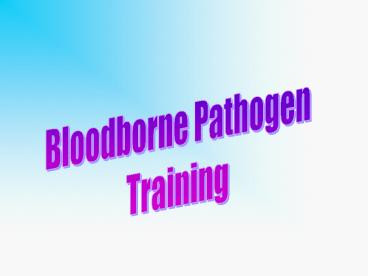COOK - PowerPoint PPT Presentation
1 / 22
Title:
COOK
Description:
WHY ARE WE HERE? OSHA Bloodborne Pathogen (BBP) standard anyone whose job requires exposure to BBP is required to complete training employees who are trained in CPR ... – PowerPoint PPT presentation
Number of Views:63
Avg rating:3.0/5.0
Title: COOK
1
Bloodborne Pathogen Training
2
WHY ARE WE HERE?
- OSHA Bloodborne Pathogen (BBP) standard
- anyone whose job requires exposure to BBP is
required to complete training - employees who are trained in CPR and first aid
- The more you know, the better you will perform in
real situations!
3
What is a BBP?
- Microorganisms that are carried in the blood that
can cause disease in humans
4
Common BB Pathogen Diseases
- Malaria
- Brucellosis
- Syphilis
- Hepatitis B(HBV)
- Hepatitis C(HCV)
- Human Immunodeficiency Virus (HIV)
5
Human Immunodeficiency Virus(HIV)
- HIV is the virus that leads to AIDS
- HIV depletes the immune system
- HIV does not survive well outside the body
- No threat on contracting HIV through casual
contact
6
Hepatitis B (HBV)
- May lead to chronic liver disease, liver cancer,
and death - Vaccination available since 1982
- HBV can survive for at least one week in dried
blood - Symptoms can occur 1-9 months after exposure
- 1-1.25 million Americans are chronically infected
- Symptoms include jaundice, fatigue, abdominal
pain, loss of appetite, intermittent nausea,
vomiting
7
Hepatitis C (HCV)
- Hepatitis C is the most common chronic bloodborne
infection in the United States - Symptoms include jaundice, fatigue, abdominal
pain, loss of appetite, intermittent nausea,
vomiting - May lead to chronic liver disease and death
8
Potentially Infectious Bodily Fluids
- Skin tissue, cell cultures
- Chewing tobacco juice
- Any other bodily fluid
- Blood
- Saliva
- Vomit
- Urine
- Semen or vaginal secretions
9
Transmission Potential
- Contact with another persons blood or bodily
fluid that may contain blood - Mucous membranes eyes, mouth, nose
- Non-intact skin
- Contaminated sharps/needles
10
Your Exposure Potential
- Industrial accident
- Administering first aid
- Post-accident cleanup
- Handling of returned product
- Janitorial or maintenance work
- Handling of any waste products
11
Universal Precautions
- Use of proper PPE
- Treat all blood and bodily fluids as if they
are contaminated - Proper cleanup and decontamination
- Disposal of all contaminated material in the
proper manner
12
Personal Protective Equipment(PPE)
- Anything that is used to protect a person from
exposure - Latex or Nitrile gloves, goggles, CPR mouth
barriers, aprons, respirators
13
PPE Rules to Remember
- Always check PPE for defects or tears before
using - If PPE becomes torn or defective remove and get
new - Remove PPE before leaving a contaminated area
- Do not reuse disposable equipment
14
Decontamination
- When cleaning up surfaces use the appropriate
cleaning solution (commercially available) - Do an initial wipe up
- Spray and allow it to stand for ten minutes then
wipe up - Dispose of all wipes in biohazard containers
- PPE should be removed and disposed of in
biohazard containers
15
Hand Washing
- Wash hands immediately after removing PPE
- Use a soft antibacterial soap
- A hand sanitizer can be used but wash with soap
and water as soon as possible thereafter
16
Regulated Medical Waste
- Liquid or semi-liquid blood or other potentially
infectious material (OPIM) - Contaminated items that would release blood or
OPIM when compressed - Contaminated sharps
- Pathological and microbiological waste containing
blood or OPIM
17
Signs Labels
- Labels must include the universal biohazard
symbol, and the term Biohazard must be attached
to - containers of regulated biohazard waste
- refrigerators or freezers containing blood or
OPIM - containers used to store, transport, or ship
blood or OPIM
18
Exposure Incident
- A specific incident of contact with potentially
infectious bodily fluid - If there are no infiltrations of mucous membranes
or open skin surfaces, it is not considered an
occupational exposure - Report all accidents involving blood or bodily
fluids - Post-exposure medical evaluations are offered
19
Post-exposure Evaluation
- Confidential medical evaluation
- Document route of exposure
- Identify source individual
- Test source individuals blood (with individuals
consent) - Provide results to exposed employee
20
Hepatitis B Vaccination
- Strongly endorsed by medical communities
- Offered to all potentially exposed employees
- Provided at no cost to employees
- Declination form
21
Recordkeeping
- Medical records include
- Hepatitis B vaccination status
- Post-exposure evaluation and follow-up results
- Training records include
- Training dates
- Contents of the training
- Signature of trainer and trainee
22
In Conclusion
- BBP rules are in place for your health and safety
- Failure to follow them is a risk that does not
need to be taken































